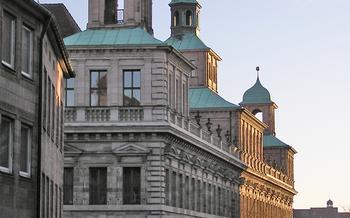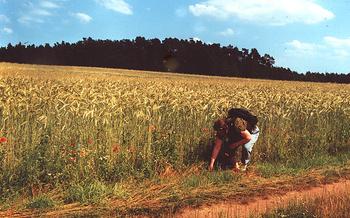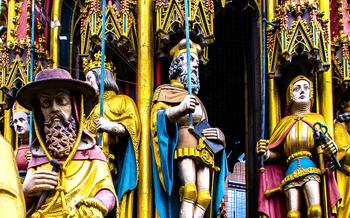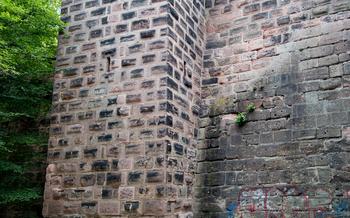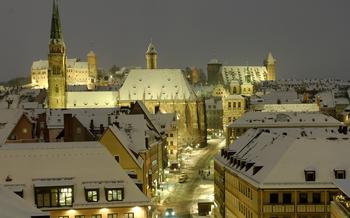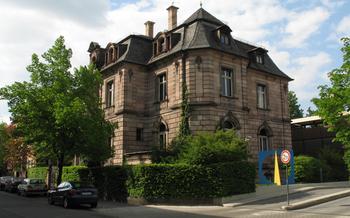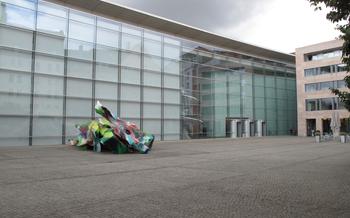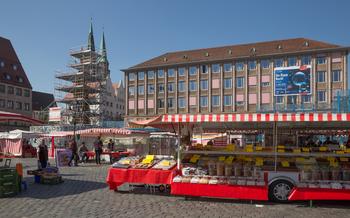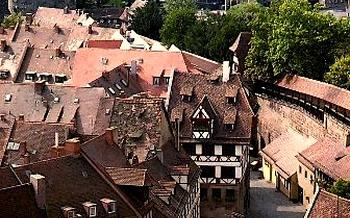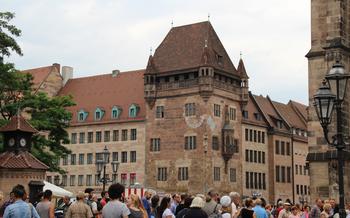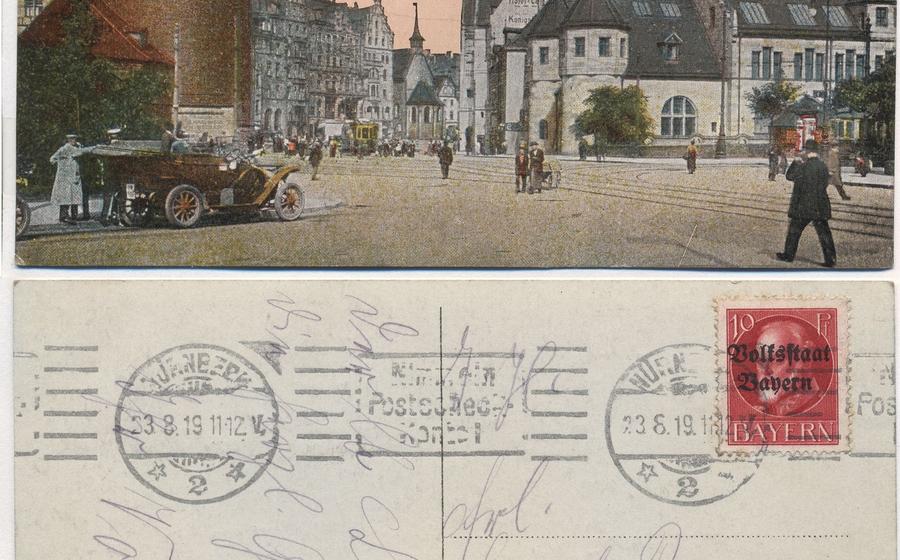
Königstor
- Königstor: A Majestic Gateway to Nuremberg's Past
- Historical Significance
- Architectural Features
- The City Walls
- The Barbican: A Defensive Outpost
- The Portcullis
- The City Museum: A Treasure Trove of Nuremberg's History
- The Dürer House
- The Hauptmarkt
- The Imperial Castle
- The German National Museum: A Treasure Trove of German History and Culture
- The Nuremberg Trials
- Insider Tip: Unveiling the Enchanting Königstor
Königstor: A Majestic Gateway to Nuremberg's Past
The Königstor, or King's Gate, stands as a testament to Nuremberg's rich history and architectural prowess. Constructed in the 14th century as part of the city's fortifications, this imposing gate served as a vital defensive structure during medieval times. Its twin towers, Gothic-style arches, and intricate stone carvings showcase the city's commitment to both functionality and aesthetics. As a symbol of Nuremberg's strength and resilience, the Königstor invites visitors to step back in time and experience the grandeur of a bygone era.
Conveniently located in the heart of Nuremberg's old town, the Königstor is easily accessible by foot or public transportation. Its proximity to other historical landmarks, such as the City Museum and the Dürer House, makes it an ideal starting point for a comprehensive exploration of the city's past.
Historical Significance
The Königstor, constructed in the 14th century, played a crucial role in Nuremberg's fortifications. As part of the city walls, it served as a defensive barrier during medieval times. Its sturdy construction and strategic location protected Nuremberg from invasion and attacks. The gate withstood numerous sieges and battles, becoming a testament to the city's resilience and strength. Over the centuries, the Königstor has borne witness to significant historical events, standing as a symbol of Nuremberg's rich and storied past.
Architectural Features
The Königstor is a captivating example of medieval architecture, showcasing impressive twin towers that flank the gate, creating a formidable presence. Gothic-style arches soar above the entrance, adorned with intricate stone carvings that tell tales of the city's past. Barbicans, additional defensive structures, and a portcullis, a heavy iron gate, were strategically positioned to enhance the gate's protective capabilities. Decorative elements, such as coats of arms and inscriptions, add a touch of grandeur to the gate's façade, reflecting the city's pride and heritage.
The City Walls
Königstor stands as an integral part of Nuremberg's extensive city walls, which once formed a formidable defensive system around the city. These walls were constructed in the 14th century to protect Nuremberg from invasion and attacks, and they remained largely intact until the 19th century. While some sections of the walls were demolished to accommodate urban expansion, several portions still stand today, offering a glimpse into the city's rich past.
Walking along the preserved wall paths provides a unique opportunity to explore Nuremberg's medieval fortifications. Visitors can trace the route of the old city walls, passing through towers, gates, and bastions that once guarded the city. The remaining sections of the walls showcase various architectural styles and features, reflecting the city's history and development over the centuries.
Strolling along the city walls offers a fascinating journey through time, allowing visitors to imagine the bustling medieval city and the challenges it faced. The preserved walls serve as a reminder of Nuremberg's resilience and the ingenuity of its inhabitants, who built these fortifications to protect their homes and livelihoods.
The Barbican: A Defensive Outpost
The Königstor's defense system was further enhanced by the presence of a barbican, an additional fortified structure situated directly in front of the gate. This strategically placed outpost served as a crucial component in protecting the city from potential intruders. The barbican's design featured a fortified tower and a gate, creating a double line of defense that made it challenging for attackers to breach. It acted as a buffer zone, allowing the city's defenders to repel assaults before they reached the main gate. The barbican's architectural features, such as its thick walls and arrow slits, provided additional protection and vantage points for the guards. Its presence significantly increased the gate's defensive capabilities, making it a formidable obstacle for any would-be invaders.
The Portcullis
The portcullis at the Königstor served as a crucial defensive mechanism during medieval times. Imagine a heavy iron grating suspended above the gate's entrance, ready to drop at a moment's notice. Operated by a complex system of ropes and pulleys, the portcullis could swiftly descend, blocking the passageway and preventing unwanted intruders from entering the city.
This ingenious device provided an additional layer of security beyond the gate's sturdy doors. When lowered, the portcullis formed an impenetrable barrier, capable of withstanding battering rams and other siege weapons. It acted as a formidable deterrent against enemy forces, making it extremely difficult for them to breach the city's defenses.
In times of peace, the portcullis served a more symbolic purpose. It was raised and lowered ceremonially, marking the opening and closing of the city gates. This ritual symbolized the city's authority and sovereignty, demonstrating its ability to control who entered and exited its boundaries.
The City Museum: A Treasure Trove of Nuremberg's History
A stone's throw from the imposing Königstor stands the City Museum, a treasure trove of Nuremberg's rich history, culture, and art. Within its walls, visitors embark on a journey through time, exploring the city's fascinating past from its medieval origins to its modern transformation.
The museum's extensive collection showcases artifacts, documents, and artworks that paint a vivid picture of Nuremberg's storied past. From ancient tools and weapons to intricate works of art, the exhibits provide a glimpse into the lives and achievements of the city's inhabitants.
Guided tours led by knowledgeable historians bring the exhibits to life, offering visitors deeper insights into Nuremberg's unique heritage. Educational programs and workshops cater to visitors of all ages, making the City Museum an ideal destination for families and history enthusiasts alike.
Whether you're interested in learning about Nuremberg's role in the Holy Roman Empire, its thriving trade and commerce, or its contributions to the arts and sciences, the City Museum offers a wealth of knowledge and inspiration. Immerse yourself in the city's captivating history and discover the stories that have shaped Nuremberg into the vibrant metropolis it is today.
The Dürer House
A short walk from the Königstor stands the Dürer House, the former residence of the renowned Renaissance artist, Albrecht Dürer. This half-timbered building, dating back to the 15th century, offers a glimpse into the life and work of one of Germany's most celebrated artists. Inside, visitors can explore Dürer's studio, where he created some of his most famous works, including the "Self-Portrait" and the "Four Horsemen of the Apocalypse." The museum exhibits showcase Dürer's artistic techniques, his influences, and his impact on the art world. Visitors can learn about his printmaking, painting, and drawing skills, as well as his contributions to the fields of mathematics and engineering. The Dürer House is a must-visit for art enthusiasts and history buffs alike, providing a unique opportunity to step into the world of this artistic genius.
The Hauptmarkt
A short walk from the Königstor, the Hauptmarkt (main market square) bustles with life and activity. Market stalls selling fresh produce, flowers, and local delicacies line the cobblestone streets, creating a vibrant atmosphere. Surrounded by historic buildings, including the iconic Schöner Brunnen fountain, the Hauptmarkt is a must-visit for any visitor to Nuremberg.
Among the highlights of the square is the Schöner Brunnen, a masterpiece of Gothic architecture. This elaborate fountain, adorned with intricate carvings and sculptures, is a symbol of the city's wealth and power. Take a moment to admire the fountain's beauty and learn about its fascinating history.
Throughout the year, the Hauptmarkt hosts a variety of cultural events and festivals. From the colorful Christmas market to the lively Altstadtfest (Old Town Festival), there's always something happening in this vibrant square. If you're lucky, you might even catch a traditional folk dance performance or a concert held against the backdrop of the historic buildings.
Whether you're shopping for souvenirs, savoring local cuisine, or simply soaking up the atmosphere, the Hauptmarkt is the perfect place to experience the heart and soul of Nuremberg.
The Imperial Castle
A short walk from the Königstor stands the imposing Imperial Castle, a testament to Nuremberg's rich history and significance. Once the residence of the Holy Roman Emperors, this magnificent castle complex offers a glimpse into the grandeur and power of a bygone era. With its towering walls, intricate architecture, and fascinating exhibits, the Imperial Castle is a must-visit for anyone interested in German history and culture.
Explore the castle's grand halls and chambers, each adorned with intricate carvings, opulent tapestries, and priceless works of art. Learn about the emperors who once resided here and the important events that unfolded within these walls. Climb to the top of the Sinwell Tower for breathtaking panoramic views of Nuremberg and the surrounding countryside.
Don't miss the chance to visit the castle's museums, which house a wealth of artifacts, documents, and interactive displays that bring the castle's history to life. Discover the stories of the emperors, their court, and the pivotal role the castle played in shaping the course of German history.
Whether you're a history buff, an architecture enthusiast, or simply seeking a unique and awe-inspiring experience, the Imperial Castle is sure to leave a lasting impression. Immerse yourself in the grandeur of this iconic landmark and feel the weight of history as you walk through its ancient corridors.
The German National Museum: A Treasure Trove of German History and Culture
Within a short walking distance from the Königstor stands the German National Museum, a treasure trove of German art, history, and culture. This renowned institution houses an extensive collection that spans from the Middle Ages to the present day, providing visitors with a comprehensive overview of Germany's rich heritage.
Among the highlights of the collection are masterpieces of painting and sculpture from various periods, including works by Albrecht Dürer, Lucas Cranach the Elder, and Hans Holbein the Younger. Visitors can also explore exhibits showcasing historical artifacts, furniture, textiles, and decorative arts, offering a glimpse into the daily lives and customs of past generations.
Temporary exhibitions and educational programs complement the permanent collection, delving deeper into specific themes and offering fresh perspectives on German history and culture. The museum's knowledgeable staff and guided tours provide visitors with insights into the significance of the exhibits, making the experience both informative and engaging.
Whether you're an art enthusiast, history buff, or simply curious about German culture, the German National Museum is a must-visit destination. Its proximity to the Königstor makes it easy to combine a visit to this iconic gate with a journey through the annals of German history and culture.
The Nuremberg Trials
The Königstor stands as a silent witness to one of the most significant events in modern history: the Nuremberg Trials. Held in the city after World War II, these trials marked a watershed moment in international law and the pursuit of justice for war crimes and crimes against humanity.
The trials were conducted in the Palace of Justice, a building located just a short walk from the Königstor. Over the course of nearly a year, 24 high-ranking Nazi officials were tried for their roles in the atrocities committed during the war. The proceedings were meticulously documented, and the evidence presented was overwhelming.
The Nuremberg Trials established the principle of individual responsibility for war crimes and crimes against humanity, regardless of the orders received. The trials also set a precedent for the prosecution of war criminals, and their legacy continues to shape international law and the pursuit of justice in cases of genocide and mass atrocities.
Today, memorials and educational initiatives in Nuremberg serve as reminders of the Nuremberg Trials and their profound impact on the world. Visitors can learn about the trials, the defendants, and the historical context that led to this pivotal event. The Nuremberg Trials stand as a testament to the resilience of the human spirit and the unwavering pursuit of justice, even in the darkest of times.
Insider Tip: Unveiling the Enchanting Königstor
For an unforgettable experience, plan your visit to the Königstor during the early morning hours or on a weekday to avoid the crowds and fully immerse yourself in its captivating ambiance. Stroll along the preserved city walls that once protected Nuremberg, offering a unique perspective into the city's rich past. Enhance your journey by exploring the nearby attractions, such as the City Museum, which houses a treasure trove of artifacts and exhibits showcasing Nuremberg's history and culture. To delve deeper into the gate's significance, join a guided tour led by knowledgeable experts who will provide fascinating insights into its construction, defense mechanisms, and historical events. Embrace the opportunity to discover the hidden gems and captivating stories surrounding the Königstor, creating lasting memories of your time in Nuremberg.
